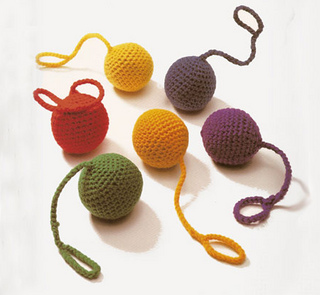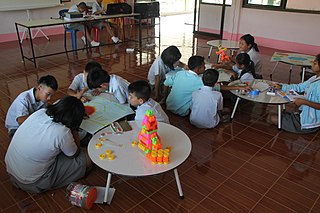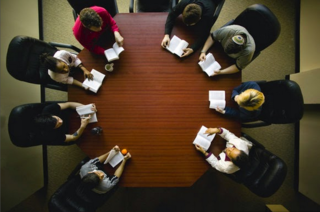Related Research Articles

Science education is the teaching and learning of science to school children, college students, or adults within the general public. The field of science education includes work in science content, science process, some social science, and some teaching pedagogy. The standards for science education provide expectations for the development of understanding for students through the entire course of their K-12 education and beyond. The traditional subjects included in the standards are physical, life, earth, space, and human sciences.
Autodidacticism or self-education is the practice of education without the guidance of schoolmasters.
Instructional scaffolding is the support given to a student by an instructor throughout the learning process. This support is specifically tailored to each student; this instructional approach allows students to experience student-centered learning, which tends to facilitate more efficient learning than teacher-centered learning. This learning process promotes a deeper level of learning than many other common teaching strategies.

Problem-based learning (PBL) is a teaching method in which students learn about a subject through the experience of solving an open-ended problem found in trigger material. The PBL process does not focus on problem solving with a defined solution, but it allows for the development of other desirable skills and attributes. This includes knowledge acquisition, enhanced group collaboration and communication.

Early childhood education (ECE), also known as nursery education, is a branch of education theory that relates to the teaching of children from birth up to the age of eight. Traditionally, this is up to the equivalent of third grade. ECE is described as an important period in child development.

Experiential learning (ExL) is the process of learning through experience, and is more narrowly defined as "learning through reflection on doing". Hands-on learning can be a form of experiential learning, but does not necessarily involve students reflecting on their product. Experiential learning is distinct from rote or didactic learning, in which the learner plays a comparatively passive role. It is related to, but not synonymous with, other forms of active learning such as action learning, adventure learning, free-choice learning, cooperative learning, service-learning, and situated learning.
Minimally invasive education (MIE) is a form of learning in which children operate in unsupervised environments. The methodology arose from an experiment done by Sugata Mitra while at NIIT in 1999, often called The Hole in the Wall, which has since gone on to become a significant project with the formation of Hole in the Wall Education Limited (HiWEL), a cooperative effort between NIIT and the International Finance Corporation, employed in some 300 'learning stations', covering some 300,000 children in India and several African countries.

Project-based learning is a teaching method that involves a dynamic classroom approach in which it is believed that students acquire a deeper knowledge through active exploration of real-world challenges and problems. Students learn about a subject by working for an extended period of time to investigate and respond to a complex question, challenge, or problem. It is a style of active learning and inquiry-based learning. Project-Based Learning is a form of experiential learning that emphasizes active, hands-on engagement with real-world problems. Project-based learning contrasts with paper-based, rote memorization, or teacher-led instruction that presents established facts or portrays a smooth path to knowledge by instead posing questions, problems, or scenarios.

Music education is a field of practice in which educators are trained for careers as elementary or secondary music teachers, school or music conservatory ensemble directors. Music education is also a research area in which scholars do original research on ways of teaching and learning music. Music education scholars publish their findings in peer-reviewed journals, and teach undergraduate and graduate education students at university education or music schools, who are training to become music teachers.
Technology integration is defined as the use of technology to enhance and support the educational environment. Technology integration in the classroom can also support classroom instruction by creating opportunities for students to complete assignments on the computer rather than with normal pencil and paper. In a larger sense, technology integration can also refer to the use of an integration platform and application programming interface (API) in the management of a school, to integrate disparate SaaS applications, databases, and programs used by an educational institution so that their data can be shared in real-time across all systems on campus, thus supporting students' education by improving data quality and access for faculty and staff.
"Curriculum integration with the use of technology involves the infusion of technology as a tool to enhance the learning in a content area or multidisciplinary setting... Effective technology integration is achieved when students can select technology tools to help them obtain information on time, analyze and synthesize it, and present it professionally to an authentic audience. Technology should become an integral part of how the classroom functions—as accessible as all other classroom tools. The focus in each lesson or unit is the curriculum outcome, not the technology."

Democratic education is a type of formal education that is organized democratically, so that students can manage their own learning and participate in the governance of their educational environment. Democratic education is often specifically emancipatory, with the students' voices being equal to the teachers'.

Student voice is the individual and collective perspective and actions of students within the context of learning and education. It is identified in schools as both a metaphorical practice and as a pragmatic concern. Tech educator Dennis Harper noted that student voice gives students "the ability to influence learning to include policies, programs, contexts and principles."
Inquiry-based learning is a form of active learning that starts by posing questions, problems or scenarios. It contrasts with traditional education, which generally relies on the teacher presenting facts and their knowledge about the subject. Inquiry-based learning is often assisted by a facilitator rather than a lecturer. Inquirers will identify and research issues and questions to develop knowledge or solutions. Inquiry-based learning includes problem-based learning, and is generally used in small-scale investigations and projects, as well as research. The inquiry-based instruction is principally very closely related to the development and practice of thinking and problem-solving skills.
Direct instruction (DI) is the explicit teaching of a skill set using lectures or demonstrations of the material to students. A particular subset, denoted by capitalization as Direct Instruction, refers to the approach developed by Siegfried Engelmann and Wesley C. Becker that was first implemented in the 1960s. DI teaches by explicit instruction, in contrast to exploratory models such as inquiry-based learning. DI includes tutorials, participatory laboratory classes, discussions, recitation, seminars, workshops, observation, active learning, practicum, or internships. The model incorporates the "I do" (instructor), "We do", "You do" approach.

Sugata Mitra is an Indian computer scientist and educational theorist. He is best known for his "Hole in the Wall" experiment, and widely cited in works on literacy and education. He is Professor Emeritus at NIIT University, Rajasthan, India. A Ph.D. in theoretical physics, he retired in 2019 as Professor of Educational Technology at Newcastle University in England, after 13 years there including a year in 2012 as visiting professor at MIT MediaLab in Cambridge, Massachusetts, USA. He won the TED Prize 2013.
High Tech High is a San Diego, California–based school-development organization that includes a network of charter schools, a teacher certification program, and a graduate school of education. Students are admitted to the public elementary, middle, and high schools through a zip-code based lottery system in an effort to admit a demographically diverse representative sample of San Diego County.
Project Learning Tree (PLT) is an environmental education program for teaching children about trees and forests using hands-on activities. It was created in 1976, after passage of the first National Environmental Education Act in 1970 and celebration of the first Earth Day in 1970, raised the profile of environmental education in the United States.

In the United States, elementary schools are the main point of delivery of primary education, for children between the ages of 4–11 and coming between pre-kindergarten and secondary education.
Design-based learning (DBL), also known as design-based instruction, is an inquiry-based form of learning, or pedagogy, that is based on integration of design thinking and the design process into the classroom at the K-12 and post-secondary levels. Design-based learning environments can be found across many disciplines, including those traditionally associated with design, as well as others not normally considered to be design-related. DBL, as well as project-based learning and problem-based learning, is used to teach 21st century skills such as communication and collaboration and foster deeper learning.

Learning space or learning setting refers to a physical setting for a learning environment, a place in which teaching and learning occur. The term is commonly used as a more definitive alternative to "classroom," but it may also refer to an indoor or outdoor location, either actual or virtual. Learning spaces are highly diverse in use, configuration, location, and educational institution. They support a variety of pedagogies, including quiet study, passive or active learning, kinesthetic or physical learning, vocational learning, experiential learning, and others. As the design of a learning space impacts the learning process, it is deemed important to design a learning space with the learning process in mind.
References
- ↑ "Sugata Mitra: The child-driven education". TEDGlobal 2010. July 2013. Retrieved December 15, 2016.
- ↑ "Sugata Mitra: The child-driven education (transcript)". TEDGlobal 2010. July 2013. Retrieved December 15, 2016.
- ↑ "About | School in the Cloud". www.theschoolinthecloud.org. Retrieved 2018-10-08.
- ↑ "Sunny Leone, Neha Singh on BBC's 100 most influential women list - Times of India". The Times of India. Retrieved 2016-12-10.
- ↑ "BBC 100 Women 2016 List: Sunny Leone and 4 Indian women in inspirational and influential list". India News Bulletin. Retrieved 2016-12-09.
- 1 2 "100 Women 2016: The girl who learnt in the cloud". BBC News. 2016-11-22. Retrieved 2016-12-08.
- ↑ "About | School in the Cloud". www.theschoolinthecloud.org. Retrieved 2018-10-09.
- ↑ "A philosophical approach to SOLE | School in the Cloud". www.theschoolinthecloud.org. Retrieved 2018-10-09.
- ↑ "Getting Started With Self-Organized Learning Environments | Edutopia". Edutopia. Retrieved 2018-10-09.
- ↑ "About Us - Blackmountainsole". Blackmountainsole. Retrieved 2018-10-09.
- ↑ "Alliance for Self-Directed Education | Home Page". Alliance for Self-Directed Education. Retrieved 2018-10-09.